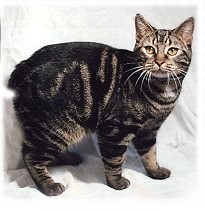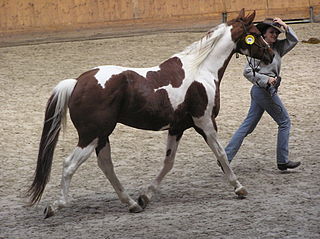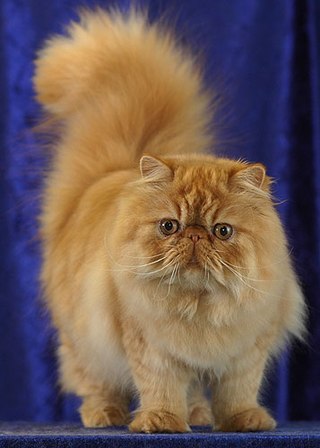
The Turkish Van is a semi-long-haired, standardised breed of domestic cat, which was developed in the United Kingdom from a selection of cats obtained from various cities of modern Turkey, especially southeast Turkey. The breed is rare, is one of the larger breeds, and is distinguished by the Van pattern, where the colour is restricted to the head and the tail, and the rest of the cat is white; this is due to the expression of the piebald white spotting gene, a type of partial leucism. A Turkish Van may have blue or amber eyes, or be odd-eyed.

The German Shepherd, also known in Britain as an Alsatian, is a German breed of working dog of medium to large size. The breed was developed by Max von Stephanitz using various traditional German herding dogs from 1899.

The Border Collie is a British breed of herding dog of the collie type of medium size. It originates in the region of the Anglo-Scottish border, and descends from the traditional sheepdogs once found all over the British Isles. It is kept mostly as a working sheep-herding dog or as a companion animal. It competes with success in sheepdog trials. It has been claimed that it is the most intelligent breed of dog.

The Manx cat is a breed of domestic cat originating on the Isle of Man, with a mutation that shortens the tail. Many Manx have a small stub of a tail, but Manx cats are best known as being entirely tailless; this is the most distinguishing characteristic of the breed, along with elongated hind legs and a rounded head. Manx cats come in all coat colours and patterns, though all-white specimens are rare, and the coat range of the original stock was more limited. Long-haired variants are sometimes considered a separate breed, the Cymric.

The Scottish Fold is a distinctive breed of domestic cat characterised by a natural dominant gene mutation associated with osteochondrodysplasia. This genetic anomaly affects cartilage throughout the body, causing the ears to "fold", bending forward and down towards the front of the head. While this trait contributes to the breed's unique appearance, often described as "owl-like", it has negative effects on the cats' welfare.

Cat coat genetics determine the coloration, pattern, length, and texture of feline fur. The variations among cat coats are physical properties and should not be confused with cat breeds. A cat may display the coat of a certain breed without actually being that breed. For example, a Neva Masquerade could wear point coloration, the stereotypical coat of a Siamese.

The Ragdoll is a breed of cat with a distinct colorpoint coat and blue eyes. Its morphology is large and weighty, and it has a semi-long and silky soft coat. American breeder Ann Baker developed Ragdolls in the 1960s. They are best known for their docile, placid temperament and affectionate nature. The name Ragdoll is derived from the tendency of individuals from the original breeding stock to go limp and relaxed when picked up. The breed is particularly popular in both the United Kingdom and the United States.

A piebald or pied animal is one that has a pattern of unpigmented spots (white) on a pigmented background of hair, feathers or scales. Thus a piebald black and white dog is a black dog with white spots. The animal's skin under the white background is not pigmented.

Skewbald is a colour pattern of horses. A skewbald horse has a coat made up of white patches on a non-black base coat, such as chestnut, bay, or any colour besides black coat. Skewbald horses which are bay and white are sometimes called tricoloured. These horses usually have pink skin under white markings and dark skin under non-white areas. Other than colour, it is similar in appearance to the piebald pattern. Some animals also exhibit colouration of the irises of the eye that match the surrounding skin. The underlying genetic cause is related to a condition known as leucism. The term is also used to describe spotting patterns in various other animals, such as goats.
Hodden is a coarse, undyed cloth made of undyed wool, formerly much worn by the peasantry of Scotland from prehistory. Hodden, with wadmal, represent two similar cultural fabrics in Scottish history. Hodden is an early-modern period name for a primarily Gaelic fabric, earlier named lachdann in Gaelic, and even earlier lachtna in Old Irish; while wadmal was a Scandinavian fabric, in the now-Scottish islands and Highlands. Both are usually woven in 2/2 twill weave but are also known in plain or tabby weave. Both are a thick, coarse, fulled homespun cloth typically made of natural undyed wool of the vari-coloured Northern European short-tailed sheep breeds. The Scots preferred to breed strains of sheep in various areas to provide the local preferred colour of natural wool used for cloth to protect the poor and rural peasants from the elements.

The Jacob is a British breed of domestic sheep. It combines two characteristics unusual in sheep: it is piebald—dark-coloured with areas of white wool—and it is often polycerate or multi-horned. It most commonly has four horns. The origin of the breed is not known; broken-coloured polycerate sheep were present in England by the middle of the seventeenth century, and were widespread a century later. A breed society was formed in 1969, and a flock book was published from 1972.

Piebaldism refers to the absence of mature melanin-forming cells (melanocytes) in certain areas of the skin and hair. It is a rare autosomal dominant disorder of melanocyte development. Common characteristics include a congenital white forelock, scattered normal pigmented and hypopigmented macules and a triangular shaped depigmented patch on the forehead. There is nevertheless great variation in the degree and pattern of presentation, even within affected families. In some cases, piebaldism occurs together with severe developmental problems, as in Waardenburg syndrome and Hirschsprung's disease.

A calico cat is a domestic cat of any breed with a tri-color coat. The calico cat is most commonly thought of as being 25% to 75% white with large orange and black patches; however, they may have other colors in their patterns. Calicoes are almost exclusively female except under rare genetic conditions.
The West African Dwarf or Djallonké is an African breed or group of breeds of domestic sheep. It is the dominant breed of West and Central Africa. This breed is primarily raised for meat. The Cameroon or Cameroon Dwarf is a breed within this group.
Colours of the Syrian hamster can be described in three ways: as "self", "agouti" or "combinations". Self colours are a consistent coat colour with the same colour topcoat and undercoat. Agouti hamsters have a ticked coat, where each individual fur is banded in different colours. Agouti hamsters also have "agouti markings" which consist of dark cheek markings, a dark marking on the head, and a light underbelly. Combinations are produced when two self or agouti colours are present.

Boaedon capensis, the Cape house snake, also known as the brown house snake, is a species of lamprophiid from Botswana, South Africa, Mozambique, Zambia and Zimbabwe. They are a non-venomous lamprophiid. This species was previously grouped in the genus Lamprophis but is regrouped with the genus Boaedon.

The Abyssinian is a breed of cat with a distinctive "ticked" tabby coat, in which individual hairs are banded with different colours. They are also known simply as Abys.

The Persian cat, also known as the Persian Longhair, is a long-haired breed of cat characterised by a round face and short muzzle. The first documented ancestors of Persian cats might have been imported into Italy from Khorasan as early as around 1620, however, this has not been proven. Instead, there is stronger evidence for a longhaired cat breed being exported from Afghanistan and Iran from the 19th century onwards. Persian cats have been widely recognised by the North-West European cat fancy since the 19th century, and after World War II by breeders from North America, Australia and New Zealand. Some cat fancier organisations' breed standards subsume the Himalayan and Exotic Shorthair as variants of this breed, while others generally treat them as separate breeds.

African village dogs are dogs found in Africa that are directly descended from an ancestral pool of indigenous dogs. African village dogs became the close companion of people in Africa, beginning in North Africa and spreading south.

Dogs have a wide range of coat colors, patterns, textures and lengths. Dog coat color is governed by how genes are passed from dogs to their puppies and how those genes are expressed in each dog. Dogs have about 19,000 genes in their genome but only a handful affect the physical variations in their coats. Most genes come in pairs, one being from the dog's mother and one being from its father. Genes of interest have more than one expression of an allele. Usually only one, or a small number of alleles exist for each gene. In any one gene locus a dog will either be homozygous where the gene is made of two identical alleles or heterozygous where the gene is made of two different alleles.

















